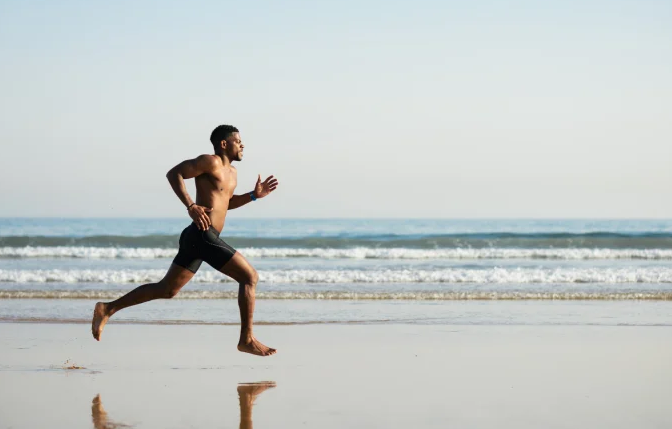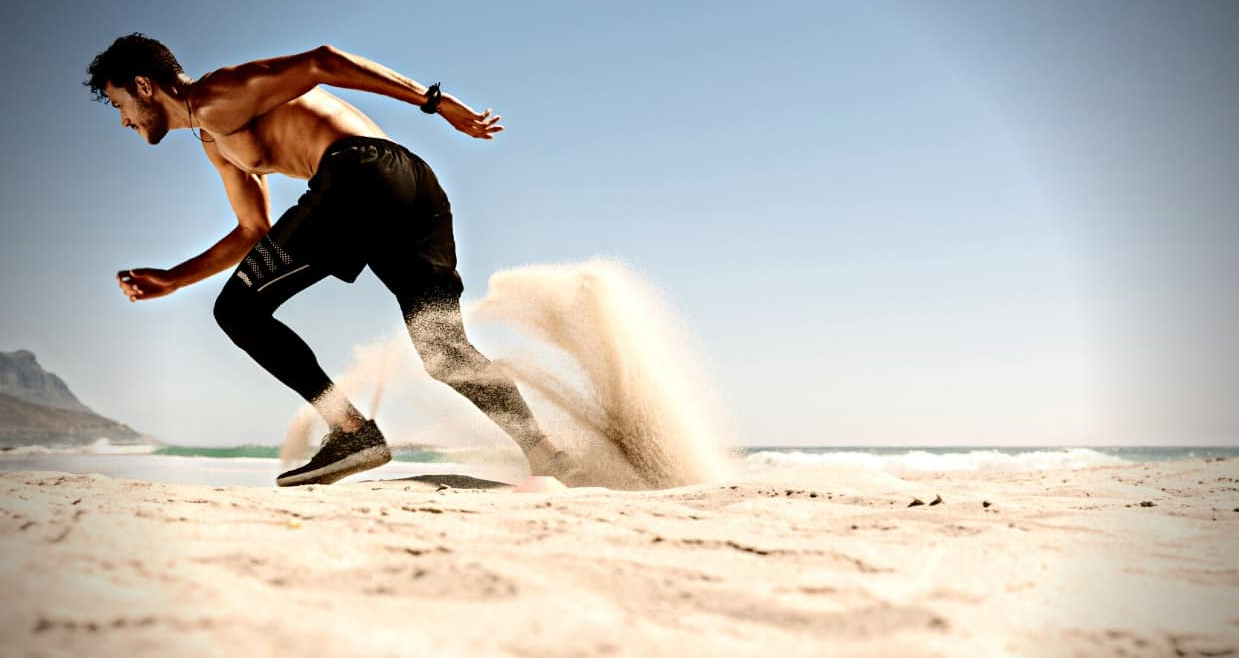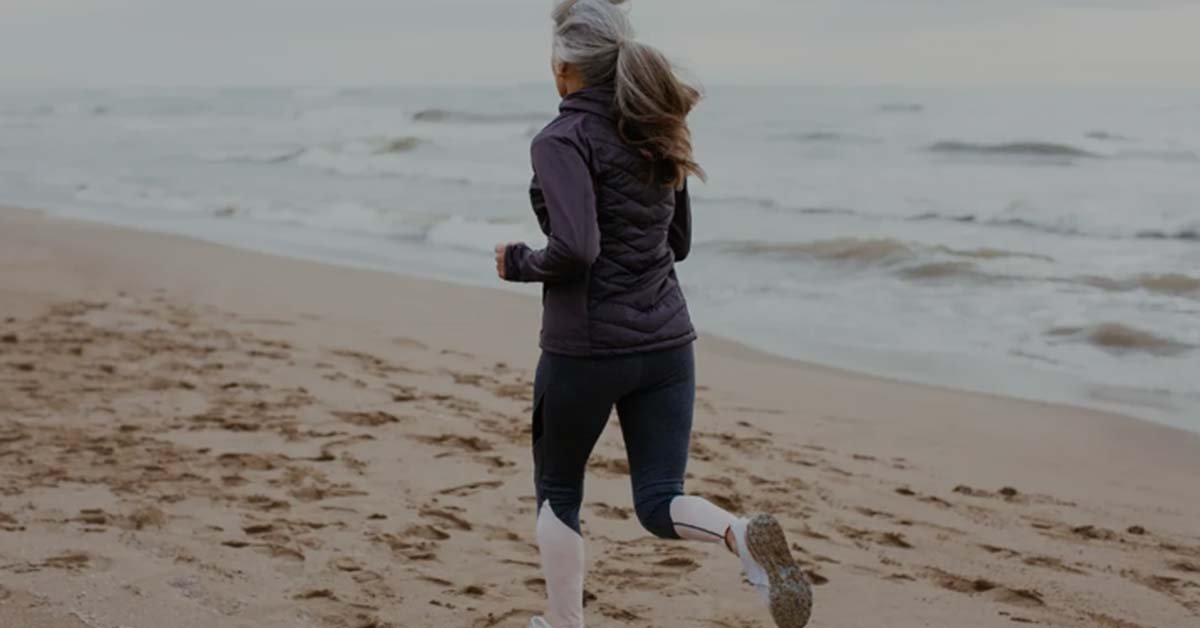This Article is Approved By » Dr. Jane Cooper (Expert Dietitian)
For many runners, the allure of pounding the sand along a scenic coastline is undeniable.
But beneath the picturesque vista lies a question: is running on sand good for you? As with most things in life, the answer isn’t a simple yes or no.
Sand running boasts unique advantages, but potential drawbacks lurk beneath the surface.
Let’s delve into the pros and cons, equipping you with the knowledge to make informed decisions about your next beach workout.
Is Running on Sand Good for You?
Running on sand can be good for you in some ways. It burns more calories and strengthens smaller leg muscles than running on firm surfaces.
However, the uneven terrain can also increase your risk of ankle and knee injuries.
It’s best to start slow and be cautious, especially if you’re not used to running on sand. If you experience any pain, stop and consult a healthcare professional.
Understanding the Biomechanics of Sand Running
- Muscle Activation: Sand’s instability activates more muscle groups, including calves, hamstrings, glutes, core, and even smaller foot muscles, than flat surfaces. This leads to improved strength, balance, and coordination.
- Impact Forces: Sand’s cushioning effect absorbs some impact, potentially reducing stress on joints like knees, ankles, and hips. However, the uneven terrain can also lead to increased lateral forces, requiring stronger stabilizing muscles.
- Energy Expenditure: The extra effort required to propel yourself through sand increases energy expenditure, leading to a higher calorie burn. Research suggests a 1.5-1.6 times increase compared to firm surfaces.

Potential Benefits of Running on Sand
- Increased Calorie Burn: Sand’s uneven terrain demands more muscle effort, leading to a higher calorie burn than flat surfaces. Studies suggest a 1.5-1.6 times increase in energy expenditure.
- Strengthens Stabilizing Muscles: The unstable surface forces your core and lower body muscles to work harder, improving balance, stability, and coordination. This can benefit runners of all levels.
- Reduced Impact on Joints: Sand’s cushioning effect can reduce stress on your knees, ankles, and hips compared to hard surfaces like pavement. This may be helpful for runners with joint pain or injuries.
- Mental Boost: Running on the beach offers a scenic change and a sense of adventure, which can enhance motivation and enjoyment.
Drawbacks of Running on Sand
- Increased Risk of Injury: The unstable surface and uneven terrain can increase the risk of ankle sprains, muscle strains, and overuse injuries. Proper form and gradual adaptation are crucial.
- Challenge for Beginners: Running on sand requires more effort and coordination, making it more challenging for beginners. It’s best to start with short distances and gradually increase intensity.
- Not Ideal for Speedwork: Sand’s resistance is unsuitable for high-intensity workouts or speed training. Stick to flat surfaces for these sessions.
- Potential for Blisters: Sand can rub against your skin, leading to blisters. Wear well-fitting shoes with good traction, and consider applying anti-blister lubricants.

Tailoring Sand Running to Your Fitness Level
- Beginners: Start with short runs on wet, firm sand, focusing on proper form and core engagement. Gradually increase distance and intensity as your fitness improves. Consider incorporating walking breaks or alternating between running and walking.
- Intermediate Runners: Once comfortable with the basics, you can try interval training, hill repeats, or dune runs to push your limits and build endurance.
- Advanced Runners: Experienced runners can use sand workouts for speedwork drills on short, flat sections of the beach, focusing on explosive power and quick strides. However, most speed training is better suited for flat surfaces.
Addressing Safety Concerns
- Injury Prevention: Warming up, cooling down, and using the proper form is crucial. Pay attention to the terrain, avoid obstacles, and listen to your body. Consider consulting a physical therapist or running coach for personalized guidance.
- Footwear: Choose trail running shoes with good traction and support to prevent slipping and stabilize uneven surfaces. Consider wearing compression socks or anti-blinker lubricants for added protection.
- Environmental Factors: Be aware of weather conditions, tidal changes, and potential hazards like rip currents. Run during daylight hours and let someone know your plans.

Advanced Techniques for Experienced Runners
- Barefoot Running: For experienced runners only, barefoot running on sand can offer additional sensory feedback and proprioception benefits, strengthening foot muscles and improving balance. Start slowly on soft sand and gradually increase duration as your feet adapt.
- Beach Sprints: Short sprints on flat, firm sections of the beach can improve speed and power. Focus on proper form, explosive acceleration, and quick recovery between sprints.
- Sand Dune Running: Hill repeats on dunes provide an intense workout for building leg strength and endurance. Start with smaller dunes and gradually progress to steeper inclines.

Making the Most of Your Beach Runs
- Combine with Other Activities: Include swimming, yoga, or beach games in your routine for a well-rounded workout and added fun.
- Explore Different Beaches: Different beaches offer varying terrain and challenges. Experiment with soft, wet sand, firmer-packed sand, or dunes for diverse workouts.
- Join a Running Group: Running with others can boost motivation, support, and offer new perspectives on sand running.

Essential Tips for Safety and Successful Running on Sand
Ready to embrace the challenge of sand running? Here are some essential tips to maximize your workout and minimize risks:
- Warm-up Thoroughly: Prepare your muscles for the uneven terrain with dynamic stretches and light jogs on firm sand before hitting the soft stuff.
- Shorten Your Strides: Take shorter, quicker steps to maintain stability and reduce the risk of rolling your ankles.
- Lean Forward Slightly: This posture helps maintain balance and prevent overstriding, which can lead to fatigue and injury.
- Listen to Your Body: Don’t push yourself too hard, especially initially. Take breaks when needed, and stop if you experience any pain.
- Stay Hydrated: The hot sun and increased exertion can lead to dehydration faster. Drink plenty of water before, during, and after your run.
- Cool Down Properly: Include static stretches to cool down your muscles and prevent post-workout soreness.
- Choose the Right Time: Running during low tide ensures a flatter, firmer surface for better stability and traction.
- Consider Guided Tours: If you’re new to sand running, joining a guided tour led by experienced instructors can provide valuable guidance and ensure your safety.
Conclusion
Running on sand can be fun and challenging to mix up your routine and improve your fitness.
However, it’s essential to consider your individual needs and limitations, starting gradually and prioritizing safety.
If you’re unsure about whether sand running is right for you, consult with a healthcare professional or certified running coach.
FAQs About Running on Sand
Is running on sand better for your joints than running on pavement?
While the soft surface of sand might seem gentler, the uneven terrain can increase stress on your ankles and knees.
However, for some people with pre-existing joint pain, the cushioning effect of sand may offer temporary relief.
It’s important to start slow, maintain good form, and listen to your body for any discomfort.
Is barefoot running on sand safe?
For experienced runners with strong, adapted feet, barefoot running on sand can be beneficial for strengthening foot muscles and improving proprioception.
However, beginners and those with foot issues should proceed with caution. Start on soft sand for short distances and gradually build up tolerance.
Be aware of potential hazards like broken glass or sharp objects.
Can I train for speed on sand?
Sand’s resistance makes it less than ideal for high-intensity speedwork. The increased effort required slows you down and can lead to fatigue.
Focus on speed training on flat surfaces and use sand workouts for building strength and endurance through hill repeats or interval training.
Is running on sand good for building muscle?
Absolutely! Sand’s instability activates more muscle groups compared to flat surfaces, especially your calves, hamstrings, glutes, core, and even smaller foot muscles.
This leads to improved strength, balance, and coordination. Consider interval training or hill repeats on dunes for an extra muscle-building challenge.
Should I wear shoes when running on sand?
Yes, wearing shoes with good traction and support is crucial on the sand. Trail running shoes are ideal for providing stability and preventing slips on uneven terrain.
Consider compression socks or anti-blinker lubricants for added protection against chafing.
Is running on the beach at low tide better than high tide?
Wet sand at low tide tends to be firmer and more compact, offering a more stable running surface compared to loose, dry sand at high tide.
However, personal preference also plays a role. Experiment with both conditions to see which feels more comfortable and challenging for you.

